Continuing our coverage of Paramount’s Famous Studios 1951-52 season. First let’s catch up with the exhibitor reaction via the industry trade reports.
Box Office Magazine (the two “Champion Shorts” articles below) ranked the Popeye cartoons 5th (in 1951) and 6th (in 1952). I don’t know know how these annual polls were determined – but its clear that Famous Studios’ Popeye shorts were still staples of the traditional movie program as of the early 1950s. Box Office is also honest enough to note the emergence of Mr. Magoo (UPA/Columbia) as something new and catching on.
Showman’s Trade Reviews (“The Leading Short Subjects” by Ralph Cokain) has a more traditional take on the shorts scene in 1952. It’s hard to argue with their top four selections (Tom & Jerry, Bugs Bunny, Warner Bros. and Disney)… but Terrytoons over Popeye or Magoo, or even Woody Woodpecker that year…?? Well okay, maybe.

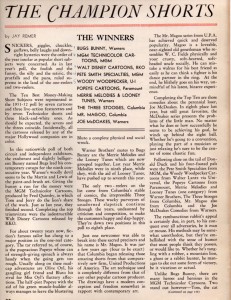

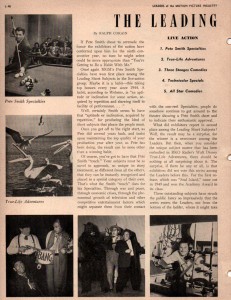
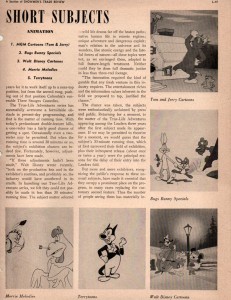
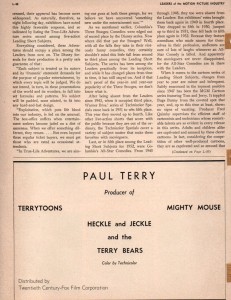

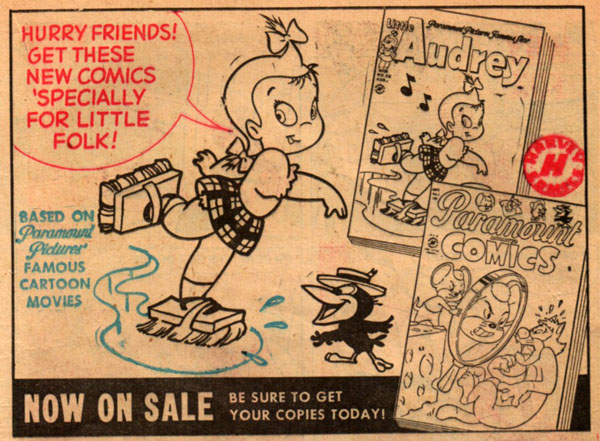
The Harvey Comics Deal
A simple licensing deal in 1951 for comic books would, in a few years, become the biggest thing that Famous Studios ever did for itself (outside of maintaining the Popeye franchise). Below is the initial 16 page contract (click to enlarge). It’s a great read.
 The agreement is dated October 16th 1951, and we assume it was a much better deal for Famous than the previous arrangements with St. John and before that with Western. St. John was currently producing a mediocre line of Little Audrey and Casper comic books.
The agreement is dated October 16th 1951, and we assume it was a much better deal for Famous than the previous arrangements with St. John and before that with Western. St. John was currently producing a mediocre line of Little Audrey and Casper comic books.
The centerpiece of this new agreement is a deal for a Little Audrey comic in particular – but it grants Harvey the rights to use other Famous characters in supporting features (in addition to Casper, Herman and Katnip, Buzzy and Baby Huey, Harvey had one page fillers with “Wiley Fox”, “Brownie Bear” and others from the Paramount canon).
Harvey had the rights to adapt stories from the animated cartoons themselves – and they certainly took advantage of that in the earliest issues. Harvey also had the right to request regular screenings of Famous Studio cartoons “upon reasonable notice”.
Harvey Comics was contractually required to print at least six issues per year of Little Audrey (no sweat); that each issue be 10¢ and 32 pages; the advertising had to be in good taste; and someone at Famous had to approve the cover and contents of each issue in advance of publication.
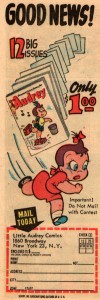 Under this agreement, Harvey agreed to provide 25 copies of each issue to Famous; and that this deal was for a two year period, which could begin as early as April 1952 (Harvey’s previous comic book deal with Archer St. John officially ended on April 1st 1952).
Under this agreement, Harvey agreed to provide 25 copies of each issue to Famous; and that this deal was for a two year period, which could begin as early as April 1952 (Harvey’s previous comic book deal with Archer St. John officially ended on April 1st 1952).
Famous had the option to opt out of the deal with four months notice (presumably the time it takes to create a typical issue). Harvey had the option to extend the deal an additional two years. Harvey was required to copyright all the comics material under Paramounts name. Most importantly, Famous had the rights to use any original characters or adapt stories used in the comics in their animated cartoons. That explains Spooky and Wendy’s appearances in Casper’s cartoons.
The contract below outlines the royalties to Famous from Harvey – keep in mind comic book sales in the early 50s were in the hundred thousands, so Famous stood to make a lot of money.
One interesting note, under paragraph 18 (page 14), says, “If Famous’ rights to characters herein licensed shall revert to Paramount, then this license shall continue except that Paramount shall be substituted in place and stead of Famous as though Paramount were the original licensor under the agreement.” This is the first time in print we have any clue that Paramount had an intent to absorb Famous – lock, stock and barrel – and “dissolve” it (as mentioned in paragraph 19).
It was signed by Isadore Sparber and Robert Harvey, and approved by Austin C. Keough (Vice President and Secretary of Paramount Pictures) on October 19th 1951.
 The first issue to appear under the Harvey imprint was Little Audrey #25 (continuing the numbering from the St. John series), issue dated August 1952 (probably hitting the newsstands in June). Steve Muffatti becomes the principal artist of Audrey for the next few years. This first issue (see contents page below) also contains the first Harvey appearances of Casper (primarily drawn by Bill Hudson and Tom Golden), Herman and Katnip, Buzzy and Baby Huey (drawn by other Famous animators, mainly Dave Tendlar and Marty Taras).
The first issue to appear under the Harvey imprint was Little Audrey #25 (continuing the numbering from the St. John series), issue dated August 1952 (probably hitting the newsstands in June). Steve Muffatti becomes the principal artist of Audrey for the next few years. This first issue (see contents page below) also contains the first Harvey appearances of Casper (primarily drawn by Bill Hudson and Tom Golden), Herman and Katnip, Buzzy and Baby Huey (drawn by other Famous animators, mainly Dave Tendlar and Marty Taras).
The following month, Harvey introduced Paramount Animated Comics (aka Harvey Comics Hits #60), cover dated September 1952, with Herman and Katnip as the lead feature. This was sort-of their “try-out” book, to see which characters would click with comic book readers. Despite an effort to push Herman and Katnip who, after all, had their own official starring series of animated cartoons, Noveltoons regular Baby Huey caught on with the younger readers of Harvey’s comics line (I guess Herman and Katnip were more aligned to adult tastes). Baby Huey took over the title completely by issue #9.
Casper The Friendly Ghost emerged in his own Harvey book with Harvey Comics Hits #61 (aka Casper #6, continuing the St. John’s numbering), cover dated October 1952. Issue #7, dated December 1952, would begin the long run of Casper’s Harvey comics – a series that ultimately ran 42 years, through mid-1994.
(click to enlarge):
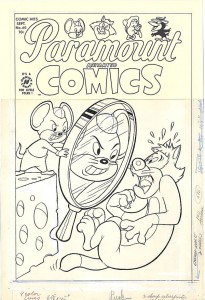

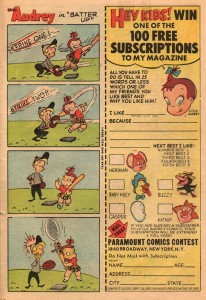



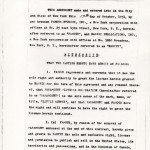
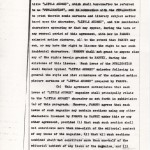
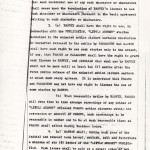
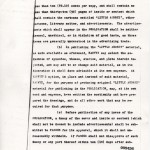

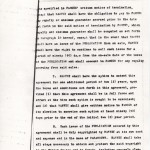

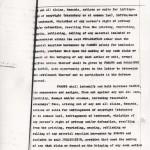


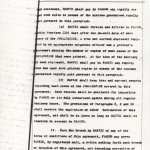
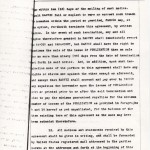
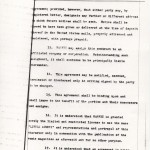
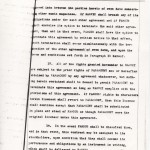
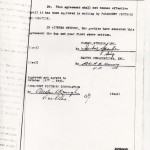
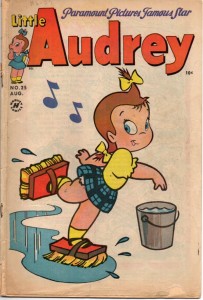
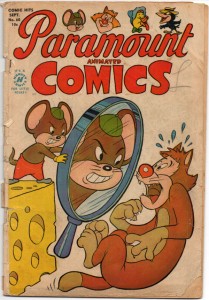

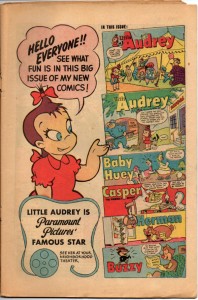
 Jerry Beck is a writer, animation producer, college professor and author of more than 15 books on animation history. He is a former studio exec with Nickelodeon Movies and Disney, and has written for The Hollywood Reporter and Variety. He has curated cartoons for DVD and Blu-ray compilations and has lent his expertise to dozens of bonus documentaries and audio commentaries on such. Beck is currently on the faculty of CalArts in Valencia, UCLA in Westwood and Woodbury University in Burbank – teaching animation history. More about Jerry Beck [
Jerry Beck is a writer, animation producer, college professor and author of more than 15 books on animation history. He is a former studio exec with Nickelodeon Movies and Disney, and has written for The Hollywood Reporter and Variety. He has curated cartoons for DVD and Blu-ray compilations and has lent his expertise to dozens of bonus documentaries and audio commentaries on such. Beck is currently on the faculty of CalArts in Valencia, UCLA in Westwood and Woodbury University in Burbank – teaching animation history. More about Jerry Beck [



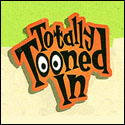



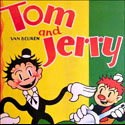
I think it was primarily the success of Heckle & Jeckle and Might Mouse that might have put Terrytoons on #5. However, the article states that Terry’s output over the years have been of a “high standard” that assured its place at #5, which makes me wonder if the author ever actually watched these cartoons.
The writer of the first “Champion Shorts” article thought that Curly was still in the Three Stooges, when in fact Shemp replaced him years earlier.
The writer of the first “Champion Shorts” article thought that Curly was still in the Three Stooges, when in fact Shemp replaced him years earlier.
He also referred to Warner’s MERRIE MELODIES as “audience participation, sing-song cartoons,” leading me to believe that whoever wrote this article didn’t bother to actually find out much about the short subjects in question.
Paramount may not have had any consolidation plans for Famous Studios in 1951, but Sam Buchwald’s death at the start of the year probably gave the studios’ lawyers pause as to a ‘what if?’ situation if the two surviving partners of Famous Studios were to pass away (both would make it past Famous demise, but Izzy Sparber didn’t make it out of the 1950s and Seymour Knieitel was dead less than 13 years after the Harvey Comics deal was signed, but did get to endure Paramount taking all their continuing characters away from the studio in a span of 2 1/2 years).
Never seen the “slanted H” logo for Harvey Comics (aka Harvey World Famous Comics) before. The Harvey comics were the second longest longest continuing running comic books line based on their Paramount cartoon characters next to the Warner Bros’s Bugs Bunny/Looney Toons-Merrie Melodies comic books. The most successful of the comics based on the Paramount/Harvey cartoons was Casper the Friendly Ghost (with 15 titles to his name including the Hanna/Barbera animated Casper and the Angels) and friends (including spin offs featuring Spooky the Tuff Little Ghost and Wendy the Good Little Witch continued until 1994 when Harvey Comics ceased operations. Most recently Dark Horse Comics (via Classic Media – now Dreamworks) had the publishing rights for Harvey Comics including Casper, Baby Huey and the rest of the Harveytoons crew.
Wait, what about “Walt Disney’s Comics and Stories”?
Anyway, I wish some new Harvey comics will be produce right now. Since DreamWorks is in a financial difficulty right now, this would be a good way to earn some extra cash for better or worse.
Anyway, I wish some new Harvey comics will be produce right now. Since DreamWorks is in a financial difficulty right now, this would be a good way to earn some extra cash for better or worse.
You would think that would make sense. I can see them sub-licensing them to IDW if they have to.
Recalling that the Baby Huey shorts were almost always Huey being sent off by his mother to play with kids who didn’t like him until the wolf showed up. The comic book stories were wolf-free and focused on Huey having comic adventures with his hapless father. On the Harveytoons set there’s only one short featuring Huey’s father; I don’t remember any others.
Was Huey’s father one of the comic book creations the studio borrowed, or was he a studio one-off who happened to catch on in the comics?
He was in two, actually.
I should mention that eventually the Harvey staff got so darn sick of the repetitiveness of the cartoons, that they decided to the comic stories their own way, hence the sudden disappearance of the wolf adversary and the introduction of Casper’s Enchanted Forest.
It was a fox not a wolf who try to get after the other duckling who treated Baby Huey very rudely until Baby Huey comes and saves them from the fox. And Baby Huey’s poppa named Alyosius had a thick Scottish Accent in the original run, but when he appeared on The Baby Huey Show Alyosius’ Scottish accent was gone. Guess the animators from Film Roman didn’t want to get him confused with Scrooge McDuck who was also Scottish.
@Nic Kramer
You’re right! How could I forgot Walt Disney Comics and Stories?
Shame on me!
They as well as the Looney Tunes (now printed by DC Comics) are still being published today as well as Walt Disney Comics and Stories (now printed by IDW Publications) and Harveytoons (Dark Horse/DreamWorks SKG) are the three longest running comics based on thier animated cartoons. Makes you wonder who’s going to resurrect the Terrytoons (Marvel had a one shot comic book based on The Mighty Heroes a few years ago) or Walter Lantz’s Woody Woodpecker and friends and return them to comic book form ?
I guess we have a difference here in what constitutes “continuously.” The Harvey line went into hibernation for four years between 1982 and 1986 (its staff going mostly to Marvel’s Top Comics, which didn’t last very long), only returning as reprint titles from ’86 through ’91, and then it laid dormant till Ape revived it briefly in 2011-13. LOONEY TUNES was dormant from the end of Whitman Comics’ last issue in 1982 and DC’s first in 1994 (and last I looked, the DC series is in reprints too). Even WALT DISNEY’S COMICS & STORIES was out of print from the last Whitman in 1984 through Gladstone’s first in 1986, then from Gladstone’s last in 1999 (there was no hiatus before or after the 1990-1994 Disney Comics stint) through Gemstone’s first in 2003, then from Gemstone’s last in 2008 through Boom’s first a year later, then from Boom’s last in 2011 through IDW’s resurrection of the series this year. For any of these series to rate as “continuous” in my book, the hiatus lengths would need to be no longer than a year–and none of them do.
Was Top Comics the same as Star Comics, Marvel’s Harvey-inspired imprint? (The art style was much like Harvey’s, and Star even had a blatant Richie Rich ripoff called “Royal Roy.”) And I recall Harvey published a New Kids on the Block comic sometime before or after their hiatus (probably inspired by the mishmash that was the NKotB cartoon).
Yeah that should be “Star Comics”, that’s where the Harvey guys went to. One of their titles early-on was “Top Dog”.
Rnigma: Yes, I meant Star Comics. The Top Comics series were repackaged Gold Key titles published in ’65-’66 and distributed (5 comics in a bag for 59 cents) through toy stores in an early version of the same distribution that eventually sank the company in 1984 after Mattel bought them out. Star Comics was Marvel’s kids comics line that initially began as an ersatz Harvey line with Sid Jacobson editing and his story and art staff providing the material, but was soon replaced by mostly licensed cartoon product like HEATHCLIFF. The Star Comics logo disappeared in 1988, with Marvel simply issuing everything under the Marvel banner.
Bill Hudson is my grandfather. I’m looking for any information about him during this time, as well as art work. Please contact me with any info on him through Harvey Comics or Fleisher Studios..thank you!!!!